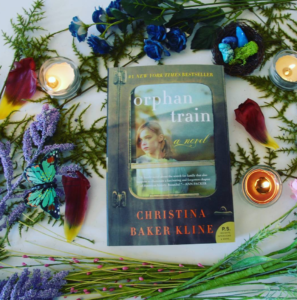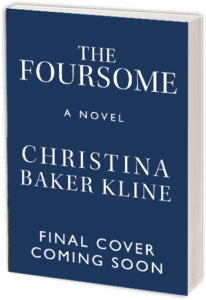- Orphan Train was a trade paperback release. And Target was one of the major outlets. Not really a conventional route to the Best Seller List.

- This was a pretty radical strategy. Was it a hard decision on your part?
- Well, did it?
- So paperback is the new black, so to speak?
- Have the books themselves—and their covers–changed?
- How important are book clubs to making a book a success?
- So the hardcover is dead then?
- So big box stores are now big players in the book business?
- So Orphan Train is a trade paperback release. And Target is one of the major outlets. Not really a conventional route to the Best Seller List.
No — and I wasn’t planning to publish in paperback. My editor at William Morrow, a HarperCollins imprint, came to me last summer and said that they felt that releasing my new novel, “Orphan Train,” as a paperback original would allow them opportunities for distribution that they wouldn’t get in hardcover. The choice was mine, she said. But I knew this was only partially true. My third novel – published, like my others, in hardcover and then in paperback – had been a regional success, but I’d tried Morrow’s patience with my fourth, which sold modestly. If I wanted to keep publishing novels with a so-called “big five” publisher – an increasingly difficult proposition in this time of turmoil in the industry – it was clear that something had to change.
- This is a pretty radical strategy. Was this a hard decision on your part?
Yes, I was really ambivalent. For years I’d understood that publishing in paperback was the kiss of death. With a paperback original you only have one shot, whereas with a hardcover you get two different opportunities, a year apart, for the book to make an impact. Often you get a new cover, a new marketing campaign, and maybe even a new publisher. And with a paperback original there’d be no way to show off reviews. Speaking of reviews, I was afraid that no respectable magazine or newspaper would deign to look at a paperback. And didn’t a flimsy paperback rather than a solid, stately hardcover diminish the accomplishment of publishing a novel?
- Well, did it?
The success of this novel has far surpassed anything I’ve done before, though of course there’s no way of knowing if the book would’ve taken off in hardcover. It probably wasn’t reviewed in as many national places, though space is so tight and book reviews are so scarce that there’s no guarantee of that in hardcover, either. (It did get a Times review and many others.) I’m on panels and at conferences with respectable quote-unquote literary writers. So — who knows? Certainly this novel’s reception has revitalized my career. Let’s face it: it’s a bleak time for hardcover literary fiction. It’s estimated that half to three-quarters of hardcovers shipped to stores are returned unsold to the publisher. It’s hard selling books in general: companies are merging, editors being laid off, bricks-and-mortar bookstores closing, large chain bookstores squeezing out independents and online retailers squeezing out chain bookstores. Convincing people to shell out $25 for a hardcover book they’ve never heard of is very different from asking them to spend $12 or $15.
- So paperback is the new black, so to speak?
Once you go paperback, you never … Actually, that’s not true. In my ideal world, my next novel would have a first printing of, say, 2,500 hardcovers for reviewers, libraries, collectors, and autograph hounds. The publisher could print more copies if they get low. And simultaneously, or six weeks later, the book would be available in paperback. The truth is, e-books are changing the landscape anyway. Many reviewers download instead of reading hard copies; my novel sells about 200 e-books for every 300 paperbacks. As one independent bookseller told me, “Hardcover to paperback used to be the model. Now, more and more, it’s paperback original to e-book.”
- Have the books themselves—and their covers–changed?
Paperbacks used to be shoddily constructed (and many still are). I still have some of my books from college, and those paperbacks are yellowed, their glue disintegrating, their spines collapsing. But paperbacks now use different glues and acid-free paper.
Orphan Train isn’t pulp fiction at all. It’s elegant and it feels nice in your hand. Morrow did a beautiful job, I think. It’s something of a hybrid between hard and soft: French flaps (extensions of the cover that fold inside the book), a strong binding and multi-finish cover (matte, glossy, metallic), deckle edging.
- How important are book clubs to making a book a success?
Absolutely huge. Book clubs make up an enormous percentage of the reading public, and many of them won’t consider hardcovers. There’s also a substantial, engaged online community of readers: Amazon,Facebook, Goodreads, Twitter, Pinterest.
- So the hardcover is dead then?
Hardcovers will never completely disappear. They are delightful to hold; they feel weighty and substantial. But my anecdotal evidence suggests that the world is changing. On the six flights I’ve taken in the past 10 days, I saw a grand total of one hardcover, and it was held by a little old lady with white hair. In hotel lobbies, by the pool, and at the beach, it was paperbacks and electronic readers.
- So big box stores are now big players in the book business?
Target, I learned, has become one of the top booksellers in the U.S. They printed 30,000 separate “book club” copies of Orphan Train (on top of the publisher’s initial print run), and asked me to sign 10,000 of them. Costco sells thousands of copies a month. And is Amazon a big-box store? It’s definitely the biggest “player.” But I also want to say that many independent bookstores are also thriving these days. The most successful ones have figured out how to become community centers, hosting reading groups, panel discussions, and other events. They hand-sell books and collaborate with libraries. Independent bookstores have been a major factor in the success of this novel — that hard-to-pin-down “word of mouth.”
